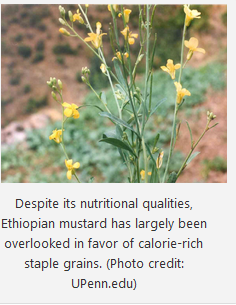 Ethiopian mustard (also known as Abyssinian mustard) lacks the bitterness of its better known cousin, kale. It’s rich in vitamins C and K, and beta carotene and calcium, as well as cancer-fighting anti-oxidants. Ethiopian mustard also produces more leaves per plant than kale and a few leaves can be removed at a time for home consumption, allowing the rest of the plant to continues to grow.
Ethiopian mustard (also known as Abyssinian mustard) lacks the bitterness of its better known cousin, kale. It’s rich in vitamins C and K, and beta carotene and calcium, as well as cancer-fighting anti-oxidants. Ethiopian mustard also produces more leaves per plant than kale and a few leaves can be removed at a time for home consumption, allowing the rest of the plant to continues to grow.
Despite its nutritional qualities, Ethiopian mustard—like many of Africa’s indigenous leafy greens—has largely been overlooked in favor of calorie-rich staple grains by researchers and farmers. As a result, the genetic diversity of the plant has dwindled. But through breeding programs, researchers are working to develop the strain’s genetic diversity for disease resistance, its applicability as a cooking oil, and as a material for industrial production.
One of these organizations is AVRDC-The World Vegetable Center. Devoted to alleviating poverty through the increase in consumption of vegetables, AVRDC has a breeding program for Ethiopian mustard in Tanzania to select for resistance to diseases and to increase leaf yields.
They have also tested combinations of organic fertilizers to determine what sorts of non-toxic solution is the best for pest management and high yields, helping make the crop an environmentally sustainable crop for local farmers.
With proper breeding management, Ethiopian mustard has the potential to spread its roots to dinner plates through its native continent and the rest of the world.
Guest Post By Andrew Boyd

Danielle Nierenberg, an expert on livestock and sustainability, currently serves as Project Director of State of World 2011 for the Worldwatch Institute, a Washington, DC-based environmental think tank. Her knowledge of factory farming and its global spread and sustainable agriculture has been cited widely in the New York Times Magazine, the International Herald Tribune, the Washington Post, and
other publications.
Danielle worked for two years as a Peace Corps volunteer in the Dominican Republic. She is currently traveling across Africa looking at innovations that are working to alleviate hunger and poverty and blogging everyday at Worldwatch Institute’s Nourishing the Planet. She has a regular column with the Mail & Guardian, the Kansas City Star, and the Huffington Post and her writing was been featured in newspapers across Africa including the Cape Town Argus, the Zambia Daily Mail, Coast Week (Kenya), and other African publications. She holds an M.S. in agriculture, food, and environment from Tufts University and a B.A. in environmental policy from Monmouth College.








